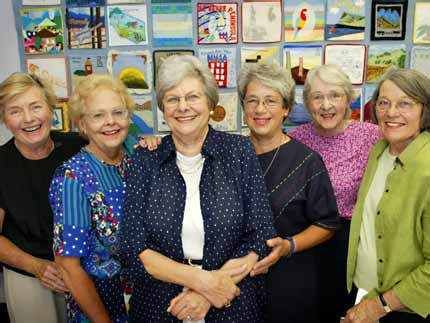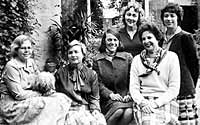Bosom pals blossom
August 5, 2004

The "bosom pals" this week, from left: Glenise Francis, Jan Barry, Mary Paton, Pat Paterson, Pauline Pick and Susan Woods.
Picture:Paul HarrisForty years ago, six women started a movement that introduced profound social change in Australia, writes Clare Boyd-Macrae.
Before 2001, the Australian Breastfeeding Association was known coyly as the Nursing Mothers Association of Australia. The reason? In 1964, when the group was founded, it was not acceptable to use words such as "breast", "pregnant" or "nipple" in print or on the airwaves. Nor would the Postmaster General's Department allow the word "breastfeeding" to be listed in the telephone directory.
How things change. To celebrate Breastfeeding Awareness Week this year, "breastfests" will be held around the world, all aiming to break the record for the number of women breastfeeding together in one place.
Tuggerah in NSW broke the record in 2001, and Adelaide took the honours in 2002, but the current record holder is Berkley, California, with 1130 simultaneous breastfeeders. This week, breastfests are being held across Australia, and in a bid to win back the title from the Americans, the ABA's South Australian branch has booked a venue with a seating capacity of 3000.
The association has been hugely influential in this profound social change, and the six women who started it all in a Melbourne living room 40 years ago still keep in touch with the ABA and with each other.
Jan Barry, who had her first two boys in 1959 and 1961, was one of the six pioneers. Her mother breastfed her children and Barry followed suit. "But back then, although the nurses were happy for you to breastfeed, you were only allowed to do it every four hours, on the dot," she says.
"The baby was brought to you for feeding and then taken away again. They were taken away for eight hours at night. We now know that these practices are not conducive to establishing breastfeeding, and that breast milk is digested in about two hours."
Those were the days when no child under 14 was allowed into the maternity ward, and husbands weren't even allowed to touch the baby until it went home. They were restricted to looking at their baby through the window of the nursery. "When I got home, I thought it was right to feed my baby every four hours. I'd let him cry, feed him after three-and-a-half hours and worry I was doing the wrong thing."
These days, information about breastfeeding is readily available. Most doctors, midwives and infant welfare nurses will tell a mother that breast milk is nutritious, confers immunity, helps prevent allergies, promotes bonding between mother and child, and decreases the likelihood of childhood obesity. (And, breastfeeding is a godsend because it is often the only time in the day you get to sit down.)
The situation was very different in the early '60s. Information and support were hard to find. Barry's friend, Mary Paton, had her first baby in 1962, gave up breastfeeding after four months and felt terribly guilty. Determined to find out more about breastfeeding, she imported some material from the La Leche League International, a support group for nursing mothers in the US that began in 1956.

Berry, Francis, Woods, Pick, Paton and Paterson in 1982.
Picture:SuppliedBarry, Paton, and four other friends, Glenise Francis, Susan Woods, Pat Paterson and Pauline Pick, then started to meet and talk about the lack of information and encouragement for young mothers to breastfeed.
Membership grew by word of mouth. They were invited to speak to groups of infant welfare nurses and doctors, and used radio and newspapers cleverly. Barry has a scrap book bulging with press cuttings dating from the '60s, including a memorable 1966 photo of Paton vacuuming in stilettos with her baby in a sling on her back.
From the start, the group had a code of ethics, it's own constitution and each of the six contributed £2 to their first bank account.
"We wanted to remain independent of government funding and control, and we needed revenue to exist and grow," says Barry. "The first NMAA shop wasn't opened until 1986; till then our homes were shops. We sewed Meh-tais (baby slings) which were sold to raise funds, and we had books and leaflets stacked under beds, on top of cupboards and in car boots. Our offices and desks were our dining room tables."
Barry was the first treasurer. Her husband was a printer and helped the fledgling group with stationery. Eventually, NMAA began producing pamphlets, a newsletter, and that stand-by for so many young families - the Nursing Mothers Cookbook.
Some people called them fanatics but the group grew. By the end of 1964 there were 54 members, 10 years later there were 10,000. Today there are 300 groups across Australia and 1400 counsellors - mothers who have received training and who have successfully breastfed their own children.
The basis of the organisation is still mother-to-mother help. Groups meet to support each other, and the trained counsellors provide help to 258,000 people every year. The 637,000 annual counselling hours have an estimated value of $10 million. ABA also has its own research and resource arm, the Lactation Resource Centre.
Since it started 40 years ago, 170,000 women have been ABA members. It's the classic story of a grassroots movement that came along at the right time. "We always had high hopes for Nursing Mothers," says Barry. "Yes, we did think it would take off. We weren't surprised by the growth because we knew there was a need for it."
Breastfeeding in public is still far from universally acceptable. Just ask Victorian MLA Kirsty Marshall, who dared to feed her baby in Parliament last year. Or Kate Langbroek, who fed her new baby live on the TV talk show The Panel. Controversy rages regularly about whether or not it's acceptable for mothers to breastfeed in shopping plazas or restaurants.
But figures illustrate the extent to which things have changed: in 1964, 15 per cent of children in Australia were breastfed at three months; this year, 83 per cent are breastfed on discharge from hospital, 52 per cent at three months and 48 per cent at six months.
In line with the pressure on work places to become more family friendly, the Commonwealth Treasury Department in the ACT is the first federal agency to be accredited as a breastfeeding friendly workplace. And the ABA has played a significant part in this - a fact noted in a Christmas card to Barry from the executive: "In appreciation of your dedication, vision and sheer hard work. You share a place in the history of Australian social change that will be long remembered."
Barry says it has been hard work, but admits it has also been fun. "It has been immensely satisfying; the friends we've made over the years, it's been just fantastic.
"Our husbands, who were most supportive, called us the bosom pals."
http://www.theage.com.au/articles/2004/08/04/1091557900427.html